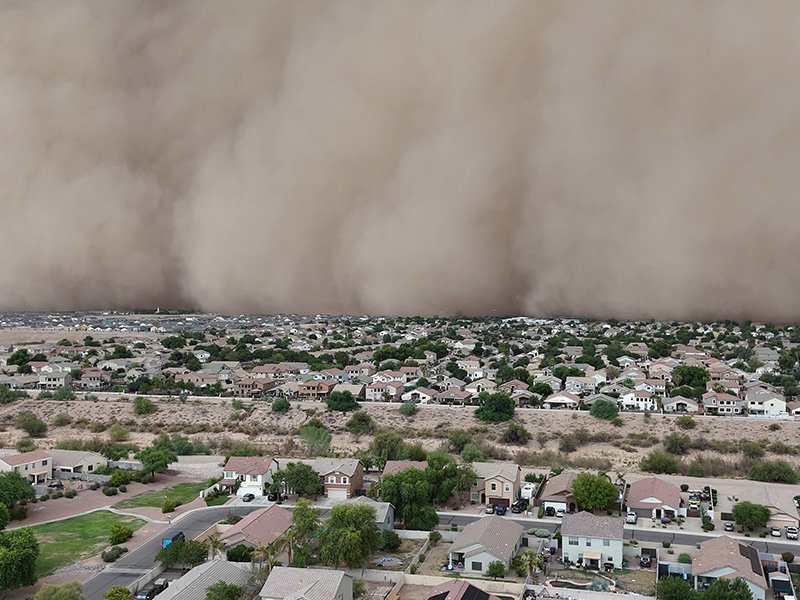Why Ants Invade Homes in the Summer
Ants are survivalists. When the outdoor environment becomes too hot, dry, or inhospitable, they look for better conditions—often inside your home. Here’s why summer brings a rise in ant activity:
Extreme Arizona Heat
If you’ve lived in the Valley for even a short time, you know how brutal the summer heat can get. Ants feel it too. When temperatures soar, they seek out cooler, shaded, and more stable environments. Your air-conditioned home offers exactly what they need to escape the heat.
Dry Conditions and Moisture Seeking
Arizona’s dry climate can also push ants inside in search of water. Kitchens, bathrooms, and laundry rooms often have the moisture they need to survive. Even something as minor as a leaky faucet or condensation near pipes can be enough to draw ants indoors.
Food Sources
Ants are always foraging for food, and your kitchen is like an all-you-can-eat buffet. Crumbs, spills, pet food, and even trash can attract ants. Once they find a reliable food source, they leave behind a scent trail that tells the rest of the colony where to go.
Nest Growth and Expansion
Summer is also prime time for ant colonies to grow. As their population increases, ants may split off to form satellite nests—some of which may end up inside your home.
Common Types of Ants Found in Phoenix Area Homes
Arizona is home to a wide variety of ant species. While most are considered nuisance pests, some can sting, contaminate food, or even damage your home. Here's a breakdown of the most common ants you might encounter:
- Odorous House Ants
Small, brown, or black ants that release a rotten coconut smell when crushed. They are common in kitchens and bathrooms. - Fire Ants
Small red ants that deliver painful stings and build unsightly mounds in yards. - Argentine Ants
Small, dark-colored ants that form large colonies. They are frequent invaders of kitchens and bathrooms. - Carpenter Ants
Large black or red ants that tunnel through wood. They don’t eat wood like termites, but they can cause structural damage. - Acrobat Ants
Small ants that raise their abdomen when threatened. These are usually just a nuisance. - Little Black Ants
Tiny ants that often appear in large numbers indoors. Another common nuisance species. - Pavement Ants
Typically found near sidewalks, driveways, and foundations. They can enter through cracks in concrete or expansion joints.
Signs of an Ant Infestation
Most people first notice ants when they see them crawling around the kitchen or bathroom. But other signs could indicate a more serious problem:
- Trails of ants along walls, counters, or floors
- Sawdust-like material (called frass), which is often left behind by carpenter ants as they tunnel through wood
- Ant hills in your yard or cracks in sidewalks and driveways
- Winged ants (especially carpenter ants), which suggest a mature colony
If you're seeing any of these signs, it's likely that more ants—and their nest—are close by.
Why DIY Ant Control Often Doesn’t Work
It’s tempting to grab a can of spray or some ant bait from the store when you see ants, but these quick fixes rarely solve the root problem. Here’s why DIY efforts often fail:
- They only kill the ants you see. Surface treatments don’t reach the nest, meaning the colony continues to grow.
- The wrong bait won’t work. Some baits are species-specific, and if you’re not targeting the right kind of ant, your efforts will come up short.
- They don’t reach the queen. Without eliminating the queen and the rest of the colony, ants will keep coming back.
- They can cause colony splitting. If ants feel threatened, some species will form new satellite colonies, spreading your problem instead of solving it.
For long-term results, it’s important to treat the entire colony, not just the symptoms you see in your kitchen.
How to Prevent Summer Ant Infestations
While keeping ants out of your home completely can be a challenge, a few good habits and preventive steps can go a long way:
- Seal cracks and gaps around doors, windows, and foundations
- Install door sweeps and repair any damaged screens
- Trim bushes, trees, and plants away from your home’s exterior
- Eliminate standing water and reduce outdoor moisture buildup
- Clean up food messes quickly, and don’t leave dirty dishes out
- Store food (including pet food) in sealed containers
- Take out the trash regularly and keep bins clean
- Repair leaks and reduce indoor humidity where possible
These strategies will help prevent ants and make your home less attractive to other pests common in our region.
How Termio Pest Control Can Help
If you’re tired of battling ants in your home, Termio Pest Control is here to help. Our trained pest control specialists know the ant species common in Queen Creek, Chandler, and throughout the Valley and how to treat them effectively. We’ll identify the source of the problem, eliminate the colony—not just the visible ants—and implement a plan to keep them from returning.
Don't waste time (and money) on DIY methods that don’t deliver. Let us handle your ant problem this summer with fast, reliable, and guaranteed results.
Call Termio Pest Control today to schedule your ant inspection and treatment. Your kitchen—and your peace of mind—deserve better.















